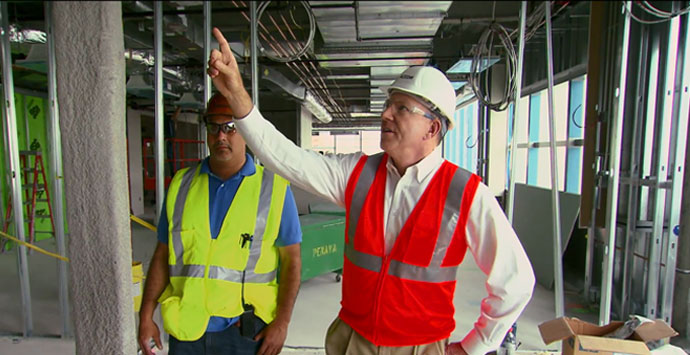#SafetyforLife: Perspectives from AECOM’s chief safety officer
In honor of World Day for Safety and Health, Andy Peters, AECOM’s chief safety officer, shares his background in safety as well as AECOM’s safety challenges and achievements.
I began my career in underground mining in the coal mines of Western Pennsylvania, United States. Safety was paramount and essential in order to survive in the harsh work environment, and I owe a lot of what I’ve learned to the coal industry and the miners who helped keep me safe. I learned the value of strong safety systems, compliance with regulations and the benefit of employee involvement in reducing injuries — all before I became a safety professional. I’m very proud of having been a coal miner and, due to my deep respect for safety, I jumped at the opportunity to become a full-time safety professional when I changed my career from mining to the construction industry.
Based on my experience in underground mining, enhancing AECOM’s culture of caring has been key to my role as the chief safety officer at AECOM. As the company strives to lead our industry in safety, health and environment performance, our expectation is that all of our employees actively participate in AECOM’s Safety for Life program and are not only their own personal safety managers, but also look out for their colleagues — as many of my fellow coal miners did for me. Employees are also encouraged to support our efforts by making observations of conditions in the office and field as well as reporting and investigating near misses.
AECOM has made great progress in reducing the frequency and severity of incidents. We can attribute this improvement to several factors, including support from executive and senior leaders as well as a focus on leading indicators that concentrate on processes for incident prevention.
We also continue to develop our systems, processes and tools to improve our ability to support our global operations with a particular focus on risk assessment and employee training. As a result, we have seen a significant reduction of injuries.

Another factor that has contributed to our success has been the addition of talented safety professionals. With the addition of URS and Hunt Construction, AECOM now has more safety-trained supervisors than many other companies in the world. In addition, we now have more certified safety professionals than many of our competitors. This combination of trained supervision and licensed safety professionals forms the foundation for AECOM’s Safety, Health and Environment (SH&E) group to perform at a world-class level.
However, with such a large workforce, a challenge we now face is ensuring that we are providing a safe work environment for all employees. The risk profile of the legacy URS and legacy Hunt projects is far more complex than the majority of AECOM’s previous projects. Since both legacy URS and Hunt self-perform construction to build their projects, this means that our direct-hire employees have exposure to construction hazards that, if not mitigated properly, could cause serious injury.
In addition, as projects become more technically complex, we are challenged to identify new methods to mitigate risk. For example, some of the new roof designs for sports arenas and buildings in the Middle East present challenges related to constructability. To address this, we are using our skills in design safety to mitigate these risks and to work with our project management staff on constructability practices, which incorporate safety practices to reduce risk to construction personnel.
Despite these inherent challenges, AECOM’s SH&E team has accomplished a lot over the past year. For example, becoming a member of the Campbell Institute is a high honor for our company as it recognizes our SH&E best practices among top organizations. We’re also very proud that our Chairman and CEO Mike Burke was selected for the U.S. National Safety Council’s “CEOs Who ‘Get It’ ” list for his dedication to building a strong culture of safety at AECOM. Personally for me, winning an AECOM CEO Award was extremely gratifying as it acknowledges all of our employees for their dedication to our Safety for Life program.
A personal safety achievement that I am proud of is being named chairman of the Safety Management Visiting Committee by my alma mater, West Virginia University. As chairman, my aim is to increase enrollment in the university’s Safety Management Program — especially given the worldwide shortage of safety professionals.
By advertising to undergraduate students early on about what a rewarding career safety can be along with the unlimited opportunities it provides, I believe we can continue to grow the pipeline of safety professionals to fill this global void. I’m also looking forward to helping plan the first Safety Symposium in the university’s history featuring leading experts from across the United States. Held in October, the symposium will be attended by employees across various industries in West Virginia, Pennsylvania and Ohio.
Please join me in celebrating AECOM’s third-annual Safety Week by checking out the AECOM Impact blog posts from our global safety professionals as well as the winner of AECOM’s safety video competition below.
 AECOM Chief Safety Officer Andy Peters has more than 35 years of experience in safety management, loss prevention and human resources, and is responsible for AECOM’s global SH&E programs. He played college football for Bobby Bowden, a famous American football coach, and in 1973, he was named the Most Valuable Player in the West Virginia University old-timers game versus the University of Pittsburgh.
AECOM Chief Safety Officer Andy Peters has more than 35 years of experience in safety management, loss prevention and human resources, and is responsible for AECOM’s global SH&E programs. He played college football for Bobby Bowden, a famous American football coach, and in 1973, he was named the Most Valuable Player in the West Virginia University old-timers game versus the University of Pittsburgh.






